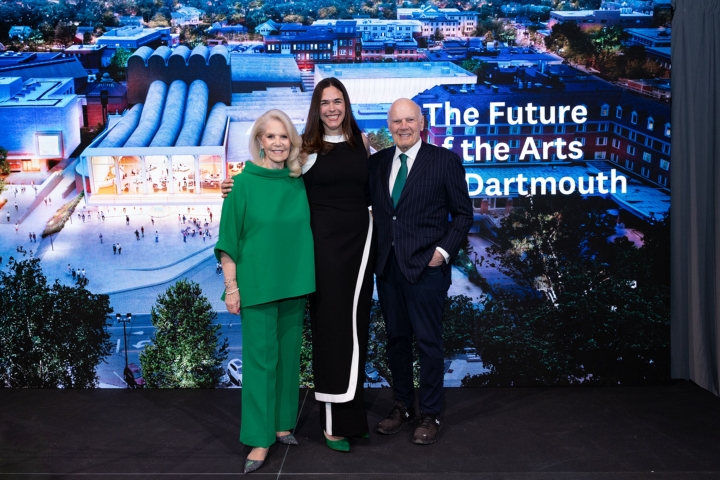Before a star-studded crowd of more than 275 alumni, trustees, and friends of the arts at Lincoln Center’s David Geffen Hall in New York City on Wednesday, President Sian Leah Beilock announced the largest gift dedicated to the arts in Dartmouth’s history.
In an evening organized to honor Daryl Roth and Steven Roth ’62, Tuck ’63, for their service to Dartmouth and their impact in their professional fields, President Beilock surprised the audience with the news of the Roths’ generosity: The Roths have given $25 million as the lead gift toward the visionary reimagining of the Hopkins Center for the Arts—an $89 million expansion and renovation that is transforming the center into a dramatic gateway to Dartmouth’s growing Arts District and to the power and importance of the performing arts at this moment in history.
Daryl Roth, an acclaimed and prolific producer on Broadway, and Steven Roth, a pioneering national business leader, have had a lifelong association with Dartmouth since Steve’s enrollment as an undergraduate in 1958.
“When you think about where they have devoted their time, energy, their gifts—Daryl in creative projects and young, new artists, Steve in buildings with purpose and effect—they are the perfect pair to invest in this project that marries both,” said Beilock, expressing her gratitude to the Roths for helping the Hop reach this milestone and for their longstanding commitment to the arts as a vehicle for innovation, empathy, and connection.
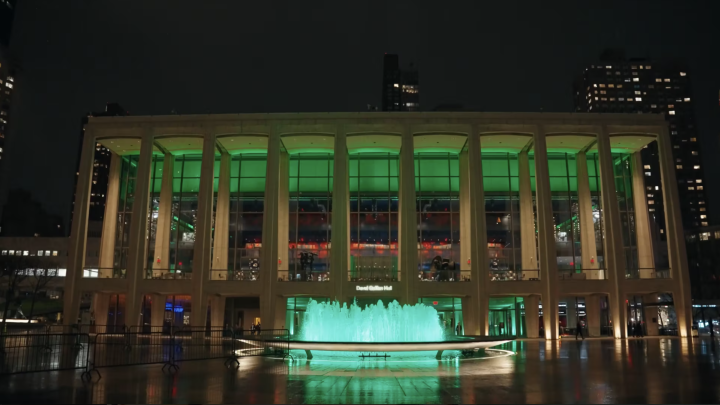
In a surprise to the Roths, Beilock also announced that a group of alumni in attendance—“moved, not only by this contribution, but by your lifetime of service and love for Dartmouth”—have together committed the final $5 million needed to reach the Hop’s construction fundraising goal.
“Daryl and Steve, thank you for helping us see this vision. It is nothing short of transforming the heart of campus—and the heart of our community, as well. We’ve spoken of a lifetime of giving back. That’s what the Roths do.”
The 15,000-square-foot expansion, now named the Daryl and Steven Roth Wing, will be the new and central point of entry to the Hopkins Center and features a state-of-the-art recital hall and performance lab, the Hop’s first dedicated dance studio, and an accessible, welcoming, landscaped plaza and entrance forum—spaces for gathering, experiencing, and creation, as envisioned by the internationally renowned design firm Snøhetta.
Steven Roth, a former Dartmouth trustee and the chairman and CEO of Vornado Realty Trust, spoke about why it matters to invest in the arts now, and how he hopes the Roth Wing and the Arts District will build on Dartmouth’s legacy for producing creative leaders for generations to come.
“The Hopkins Center opened in the year of my graduation, and its unique architecture in the context of Dartmouth is courageous,” Roth said. “We are moved to support areas of true faculty distinction. We believe that should be in the arts—theater, dance, music, writing, filmmaking, and painting. We hope this new wing will be an inviting gateway to a world-class Arts District.”
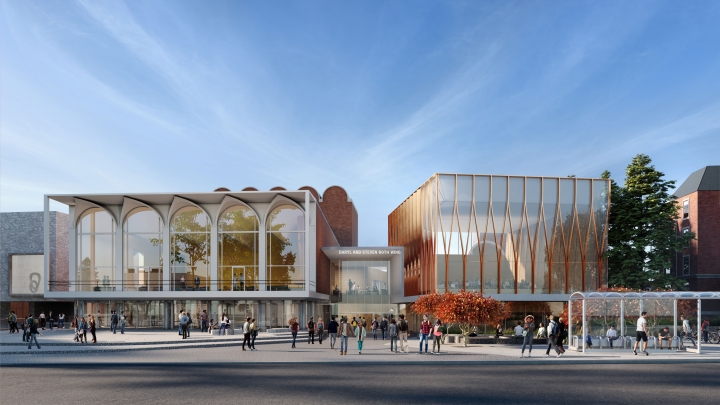
Daryl Roth, a Tony Award-winning theater producer who has brought more than 120 productions to the stage on- and off-Broadway, spoke of how the arts cultivate hope and understanding in a turbulent world.
“We feel that the new wing at the Hop will be a place that brings people together and that this space will welcome programs that engage and inspire. I believe theater, in particular, can be the ultimate bridge builder, with stories that open our hearts and minds and take us places where we can come to better understand ourselves and others,” she said.
In addition to adding the Roth Wing, the Hop is revitalizing 55,000 square feet of existing space, including an augmented Spaulding Auditorium, a renewed Top of the Hop, and acoustically optimized practice and rehearsal rooms throughout the building. The project, which began in the winter of 2022-23, is on track to be finished in 2025.
The renewed Hop joins the recently expanded and renovated Hood Museum of Art, the Black Family Visual Arts Center, and the Maffei Arts Plaza in creating a centralized Arts District that makes clear the value Dartmouth places on the arts as a vehicle for discovery, innovation, and connection across cultures and worldviews. Proximity of the visual and performing arts in state-of-the-art facilities offers students, faculty, and visiting artists a platform for interdisciplinary collaboration and creative production.
The campaign for the Arts District was launched under then-President Philip J. Hanlon ’77 in 2014 and sought to raise $139 million. With the construction funds now raised, Beilock told the crowd she was committed over the next year to continuing the Hop campaign to raise resources for dynamic programming to animate the Hopkins Center for years to come.
Dartmouth Takes Manhattan
The fountain in front of David Geffen Hall was colored green for the occasion, and guests were encouraged to wear green and white.
Highlights of the evening included appearances by comedians Rachel Dratch ’88 and Tina Fey, and performances by undergraduates, including the Dartmouth Aires and trumpeter Jacob Crawford ’27. Dartmouth touted the Hopkins Center’s legacy of fostering creative talent with a video tribute featuring Dratch, producer and Shondaland founder Shonda Rhimes ’91, actresses Connie Britton ’89 and Sharon Washington ’81, composer and producer Kabir Sehgal ’05, dancer and choreographer Jamey Hampton ’76, and Timothy O’Leary ’97, general director of the Washington National Opera at the Kennedy Center.
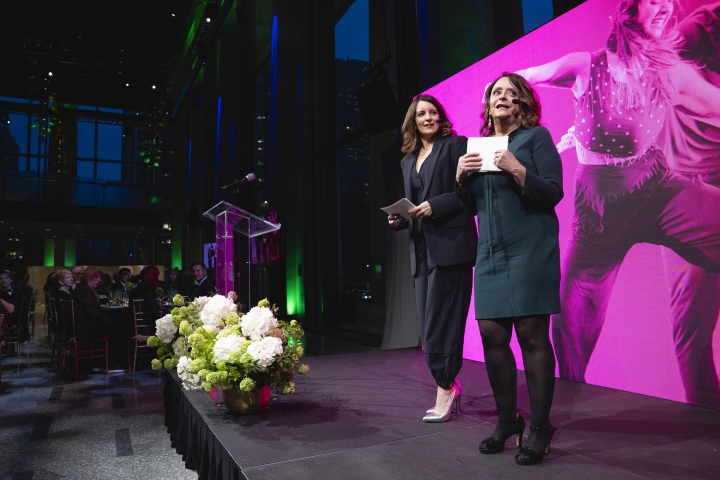
“The Hop is the place where I have my best memories at Dartmouth. It really felt like home to me,” Dratch told the audience. “Not to sound corny, but I made my best friends there, and they’re still my best friends to this day. And some of them are sitting right over at table 24 right there. So I’m really looking forward to seeing all the dazzling changes coming our way.”
Among the speakers honoring the Roths and the breadth of Dartmouth’s reach in the art world were Pulitzer Prize-winning playwright Paula Vogel and chair emeritus of the Dartmouth Board of Trustees Bill Helman ’81.
Vogel spoke of Daryl Roth’s influence in the theater world, particularly in supporting women’s voices, including her own.
“I want to thank Daryl for opening a door in my life,” Vogel said. “I want to thank the Dartmouth community for also making the arts a central place of education. Daryl has given us a role model to follow so that we can bring forward grace in the 21st century, to our America. So, thank you, Daryl, for bringing us grace—to the Dartmouth campus, to the writers you lift, and to theater in this country.”
Helman took the stage next and pulled out a bobblehead likeness of Steven Roth. “Introducing Steve Roth is not an easy assignment,” he said. “There is no one—no one in this room or in the Dartmouth community—who appreciates what Dartmouth has done for them, and who is more committed to the current and future success of Dartmouth and of the institution. No one better than Steve Roth.”
Mary Lou Aleskie, the Howard L. Gilman ’44 Executive Director of the Hop, and John Stomberg, the Virginia Rice Kelsey 1961s Director of the Hood Museum of Art, represented the Dartmouth arts community. Aleskie introduced Snøhetta architects Craig Dykers and Nick Anderson, who presented an animated “fly-through” of what the completed Hop expansion will look and feel like.
Also reflecting on the power of the arts and of the Roths’ philanthropy were Laurel Richie ’81, chair of the Hop Board of Advisors and chair emerita of the Board of Trustees, and Peggy Epstein Tanner ’79, trustee emerita and chair of the President’s Leadership Council.
“This is a watershed moment for us,” Richie said. “With this expansion of our arts offering, we’re going to make a difference not just on our campus, but out in the world.”
About the Roths
Daryl Roth and Steven Roth have long been generous and loyal supporters. In addition to their support for the arts, they have endowed three professorships and the Roth Visiting Scholar program and provided the lead gift to create the Roth Center for Jewish Life, home to Hillel at Dartmouth and the Upper Valley Jewish Community.
Steven Roth was a trustee from 2008 to 2016, and has served on the Tuck Board of Advisors, the Dartmouth Alumni Council, and the President’s Leadership Council, among other Dartmouth service.
In addition to leading Vornado, one of the largest owners and managers of commercial real estate in the United States, he is the chairman and CEO of the real estate firm Alexander’s, Inc.
He formerly served as vice chairman of the Intrepid Museum Foundation, chair of the National Association of Real Estate Investment Trusts; director of Partnership for New York and the Jewish Theological Seminary of America; and as a trustee of Barnert Memorial Hospital, Horace Mann School, New York University School of Medicine Foundation, and the Whitney Museum of American Art.
Among numerous recognitions, Steven Roth was named #8 on the Real Estate Power 100 List of the City and State of New York in 2022, and was named by Barron’s as one of the World’s Most Respected CEOs from 2005 to 2007.
Daryl Roth is the owner and operator of the Daryl Roth Theatre in Union Square and its annex, the DR2 Theatre. She has produced seven Pulitzer Prize-winning plays, including Clybourne Park, August: Osage County, Anna in the Tropics, Proof, Wit, How I Learned to Drive, and Three Tall Women, and has garnered 13 Tony Awards, more than 10 Drama Desk Awards, and an Olivier Award, for productions including Kinky Boots, Indecent, and The Normal Heart. She was inducted into the Theater Hall of Fame in 2017.
She is a trustee of the John F. Kennedy Center for the Performing Arts and an honorary trustee of the Lincoln Center Theater.
An Apt Venue
The choice of the world-renowned Lincoln Center as a venue to celebrate Dartmouth’s global impact in the arts was an appropriate one, as more than one speaker observed.
The Hop was originally designed by Wallace Harrison, who went on to use many of its signature architectural elements in the design of Lincoln Center’s Metropolitan Opera House, which opened in 1966, four years after the Hop.
“In fact, the Hop preceded the Met, which is just out the window over there,” Dykers said. “And it’s amazing to think that this legacy is surrounding us all tonight, and when we return to Dartmouth it will be there, too.”
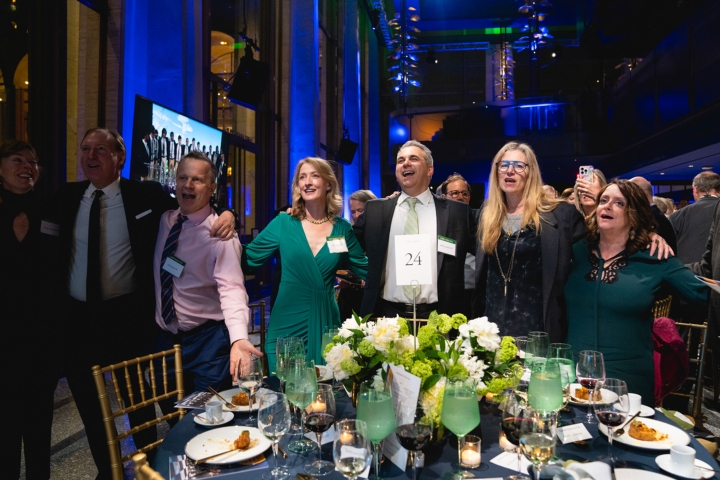
The two institutions share a common mission of supporting and creating broad access to groundbreaking artistic creations and fostering the next generation of performing artists. Today, four alumni—Cecily Carson ’98, Susan Huang ’84, Rhimes, and Diana Taylor ’77—sit on Lincoln Center’s board of directors.
Snøhetta’s design honors and preserves Harrison’s original vision for the Hop while fully updating the building to support the needs of the future.
Lincoln Center has announced that The Ritual of Breath Is the Rite to Resist—an immersive opera created by visual artist and Dartmouth Professor of Studio Art Enrico Riley ’95 in collaboration with composer Jonathan Berger and poet and Dartmouth Professor of English and Creative Writing Vievee Francis—will headline its summer festival at Damrosch Park in July.
The production was developed, commissioned and produced by the Hop, where it premiered in 2022. It was then presented by Stanford Live, a co-commissioner of the project.
Aleskie said the production is just one example of the important work in the arts that Dartmouth will be fostering through the Hop.
“The arts build a more empathetic and understanding society,” Aleskie said. “This dynamic new wing honors the legacy of this beloved building, while offering us capacities in teaching and innovation that would have been unimaginable when the Hop first opened. It is with deep gratitude that we celebrate the boundless potential of the arts to bring people closer together in this incredible setting.”
